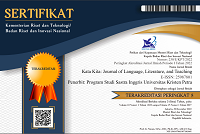The Speech Styles Used by Female and Male Guests on The 20 Under 20 Podcast
DOI:
https://doi.org/10.9744/katakita.13.1.107-116Abstract
This study explores the use of speech styles by the two of the guests in two podcast episode series released by Raymond Chin. The videos analyzed are titled “Omzet 3.5m per Bulan di Umur 19 Tahun?! Ft. Faiz- 20 Under 20 Episode 11” and “Bisnis Ratusan Juta Dulunya Di Cap “Gabakal Sukses” ft. Eva Alicia- 20 Under 20 Episode 4”. The two episodes of the podcast have two different guests, the female guest is Eva and the male guest is Faiz. Based on Baxter (2010) theory of speech styles, Baxter (2010) divides speech styles into two categories, the first of which is connected with female speech styles, namely: personal, compliant, polite, cooperative, and process-oriented. Second, male speech styles are connected with the following speech characteristics: matter-of-fact, assertive, aggressive, use of humor, ego-enhancing, and goal-directed. A descriptive qualitative approach was used by examining video transcripts to identify examples of speech styles. The findings reveal similarities in the use of speech styles between female guests and male guests, highlighting similarities in male and female speech styles features. This research concludes that the use of speech styles that are based on gender by Baxter is used by both of the guests, despite their gender. This research contributes to the understanding of speech styles in corporate communications and offers insights for future studies of speech styles in various business-related contexts.
Downloads
Published
Issue
Section
License
Authors who publish with this journal agree to the following terms:- Authors retain copyright and grant the journal right of first publication with the work simultaneously licensed under a Creative Commons Attribution License that allows others to share the work with an acknowledgement of the work's authorship and initial publication in this journal.
- Authors are able to enter into separate, additional contractual arrangements for the non-exclusive distribution of the journal's published version of the work (e.g., post it to an institutional repository or publish it in a book), with an acknowledgement of its initial publication in this journal.
- Authors are permitted and encouraged to post their work online (e.g., in institutional repositories or on their website) prior to and during the submission process, as it can lead to productive exchanges, as well as earlier and greater citation of published work (See The Effect of Open Access).














